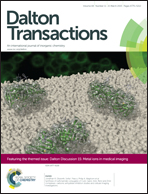Towards understanding the design of dual-modal MR/fluorescent probes to sense zinc ions†
Abstract
A series of gadolinium complexes were synthesised in order to test the design of dual-modal probes that display a change in fluorescence or relaxivity response upon binding of zinc. A dansyl-DO3ATA gadolinium complex [GdL1] displayed an increase and a slight blue-shift in fluorescence in the presence of zinc; however, a decrease in relaxation rate was observed. Consequently, the ability of the well-known zinc chelator, BPEN, was assessed for relaxivity response when conjugated to the gadolinium chelate. The success of this probe [GdL2], lead to the inclusion of the same zinc-probing moiety alongside a longer wavelength emitting fluorophore, rhodamine [GdL3], to arrive at the final iteration of these first generation dual-modal zinc-sensing probes. The compounds give insight into the design protocols required for the successful imaging of zinc ions.

- This article is part of the themed collection: Dalton Discussion 15: Metal ions in medical imaging

 Please wait while we load your content...
Please wait while we load your content...